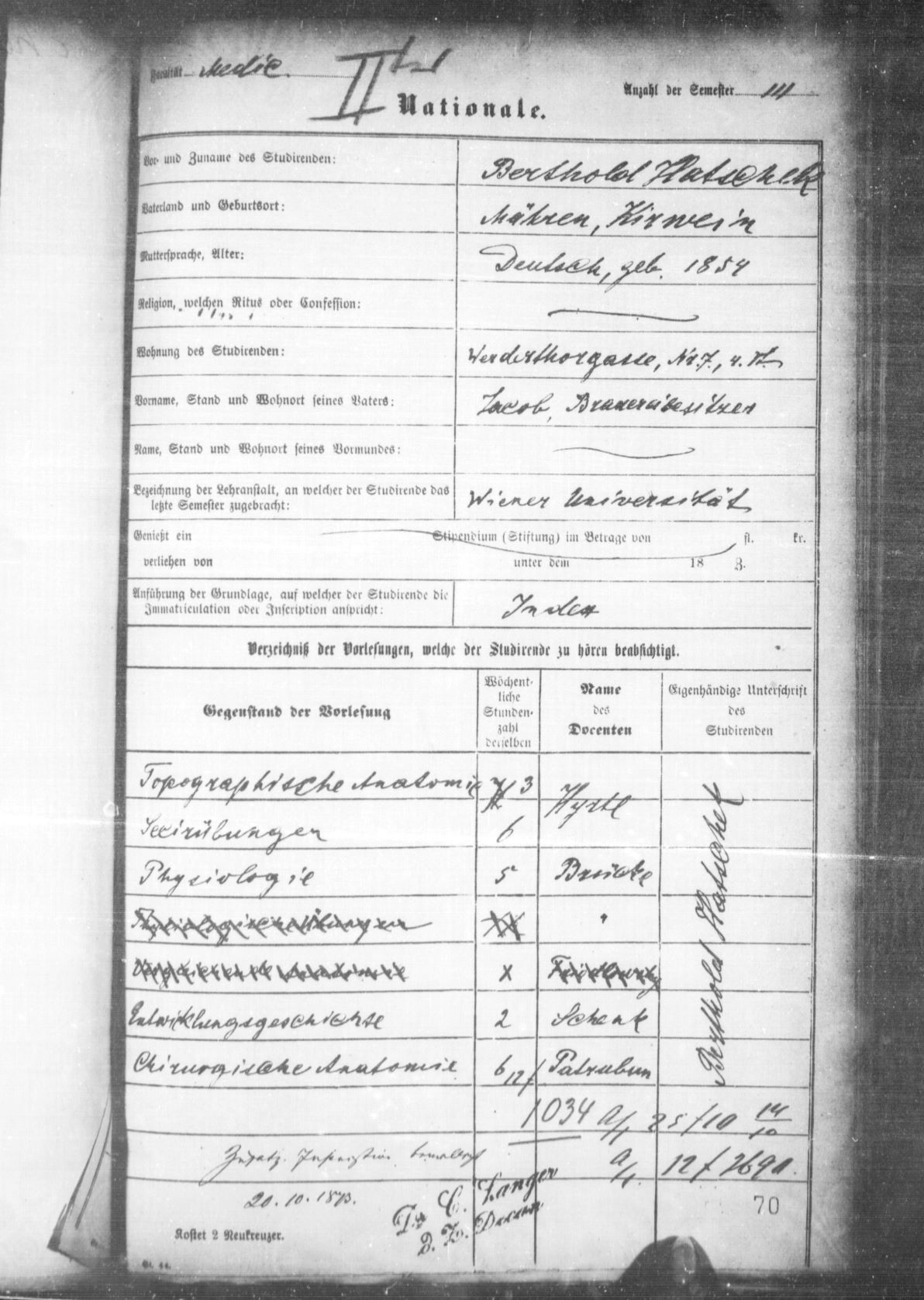
| Born: | 04-03-1854 |
| Faculty: | Philosophical School |
| Category: | Expelled teacher |
Berthold HATSCHEK (born on April 3rd, 1854 in Kirwein, Moravia, Austro-Hungarian Empire [Skrbeň, Czech Republic], died on January 18th, 1941 in Vienna) was emeriuts professor for zoology at the Philosophical School of the University of Vienna.
He was persecuted in times of Nazism as a Jew, lost his position and was expelled from the University of Vienna in 1938.
Berthold Hatschek, son of Jacob Hatschek (1822-1910, brewery owner) and Rosa, née Back (1827-1911), attended secondary school in Linz and in 1872[1] began studying medicine and natural sciences at the Universities of Vienna, Leipzig and Munich.[2] He obtained his doctorate in 1877 with the paper “Beiträge zur Entwicklungsgeschichte der Lepidopteren”.[3] He then worked as a private scholar[4] and habilitated as a private lecturer for zoology at the University of Vienna in July 1879.[5]
Already in 1895 he received a professorship as the successor of Friedrich Stein[6] at the German University in Prague, after making a name for himself with important embryological research. In morphological studies, he was able to develop basic laws of formation of lower and higher worms and moss animals as well as vertebrates. One year later, in 1896, he became the head of the 2nd zoological comparative-anatomical institute as successor of the retired Carl Claus.
Since 1898 he was married to painter Marie Olga Rosenthal (1869-1942) and they had two daughters - Augusta (married: Dessauer, 1899-1996) and Anna Maria (married: Geschwind, 1901-1967).
Hatschek could not continue in the vein of his previous important work in Vienna, since he suffered from depression that increasingly became worse. He published less and less research results, his planned works, e.g. a "Lehrbuch der Zoologie" remained unfinished. Only occasionally news about the development of a new morphology of vertebrates was published, although he had already done significant work on it. After the First World War he withdrew completely and stopped publishing completely.[7] He did, however, remain in his teaching position until the academic year 1924/25.[8]
Because of his Jewish religion, the National Socialists removed him from office in April 1938. His property was dispossessed and he was thrown out of his apartment. He passed away on January 18th, 1941, at the age of 87.[9]. His daughters were able to emigrate to the USA and England respectively, his wife shortly after to Belgrade/Yugoslavia, where she was murdered in 1942 in the vicinity of the Banjica concentration camp.[9a]
Despite only publishing works for a short time due to his illness, Hatschek had a significant impact on zoology and most of all influenced comparative morphology, even though he only focused on a few objects. He chose particular animal shapes and with these explained the blueprint of whole groups of animals, for example using the lancelet (amphioxus) as a stand-in for the group of vertebrates.[10] He is the namesake of a groove in the lancelets’ dorsal roof of the mouth called "Hatschek’s pit".[11] Furthermore, his trochophora-theory showed phylogenetic connections between animal groups that were far apart from each other. He also created the phylum of zygoneura, the genus of swamp gnats.[12]
Among Hatschek’s most famous works are the "Lehrbuch der Zoologie" (1888) and "Das neue zoologische System" (no year).[13]
In 1896 he became a corresponding member and in 1932 a full member of the Academy of Sciences. He held the title of Hofrat[14] and belonged to the Leopoldina in Halle.[15] He also was a member of the imperial-royal scientific exam commission for the teaching exam for secondary schools as well as a full member of the Gesellschaft zur Förderung deutscher Wissenschaft, Kunst und Literatur (Society for the Support of Science, Art and Literature) in Bohemia.[16]
In the Bio-Center at University-Center-Althanstraße (UZA I), opened in 1982, a lectureroom was named "Berthold Hatsch Uebungssaal 8" (room number UZA I, EB 01, 1.053).
On December 13th, 2011, in the Bio-Center at University Center Althanstraße (UZA I), which was opened in 1982, the practice room 8 (RoomNo. UZA I, EB 01, 1.053) was named after him in "Uebungssaal Berthold-Hatschek", with an opening lecture by Manfred Walzl: "Berthold Hatschek, early embryologist and eponym of the former 'Uebungsraum 8'".[17]
Hatschek's estate at the former Zoological Institute of the University of Vienna has been processed by von Monika Schreiber from the NS-Provenance Research Section of the University Library.[18]
Lit.: Österreichisches Staatsarchiv/AVA, PA Hatschek; Archiv der Universität Wien/PH PA 1894; MÜHLBERGER 1993, 40; CZEIKE 1994, Vol. 3; FREUDIG/COLLATZ 1996; KILLY/VIERHAUS Vol. 4 1996; Österreichische Akademie der Wissenschaften (ÖAW), Hg., Österreichische Naturforscher und Techniker, Wien 1951; OeBL Vol. 2 1959; Gedenkbuch für die Opfer des Nationalsozialismus an der Österreichischen Akademie der Wissenschaften; Manfred G. Walzl u. Monika Schreiber, Neues aus der Vergangenheit: Die persönlichen Dokumente des Professor Berthold Hatschek (1854-1941) und seiner Familie am ehemaligen Zoologioschen Institut der Universität Wien, in: Schriften zur Verbreitung naturwissenschaftlicher Kenntnisse 154 (2018), 17-42.
[1] ÖStA/AVA, PA, k. k. Ministerium für Cultus und Unterricht, 10979/1879, CV, o. D.
[5] UA, PA, Ministerium für Kultus an Unterricht an PHIL Dekanat, 25. 7. 1879.
[6] ÖStA/AVA, PA, k. k. Ministerium für Cultus und Unterricht, Kommission zur Wiederbesetzung der zoologischen Lehrkanzel an das Professorenkollegium der philosophischen Fakultät der Universität Wien, 8. 7. 1896.
[7] Österreichische Akademie der Wissenschaften (ÖAW), Hg., Österreichische Naturforscher und Techniker, Wien 1951.
[8] UA, PA, BMU an PHIL Dekanat, 8. 3. 1924.
[9] ÖAW 1951.
[9a] WALZL/SCHREIBER 2018, 34f.
[11] Doris FREUDIG/Klaus Günther COLLARZ, Lexikon der Naturwissenschaftler. Astronomen, Biologen, Chemiker, Geologen, Mediziner, Physiker. Heidelberg/Berlin u. a. 1996.
[14] Ebd.
[16] ÖStA/AVA, PA, k. k. Statthalterei-Präsidium in Böhmen an das Ministerium für Cultus und Unterricht, o. D.
Andreas Huber (translated by Thomas Rennert)
